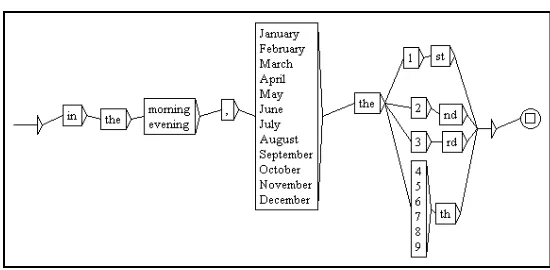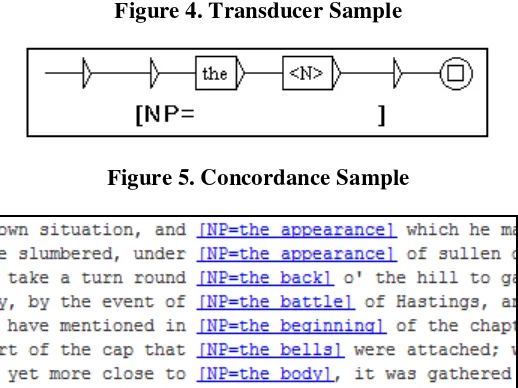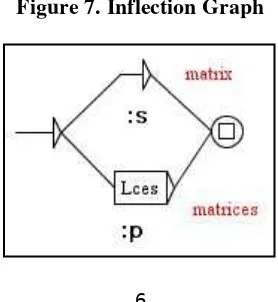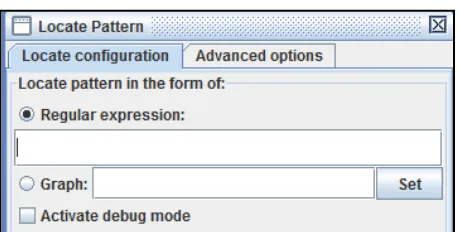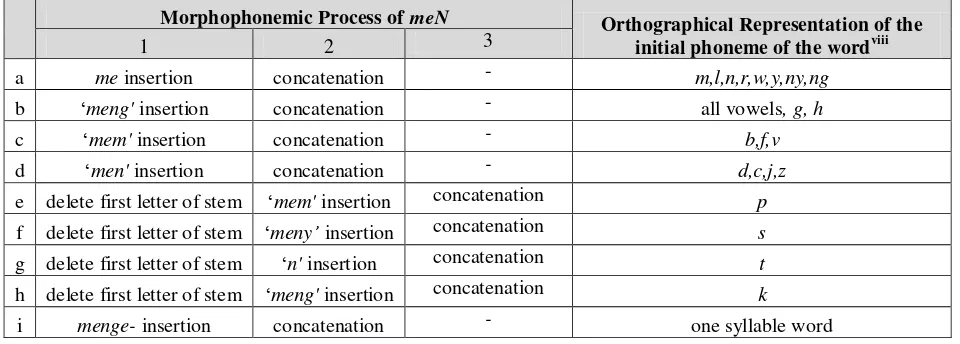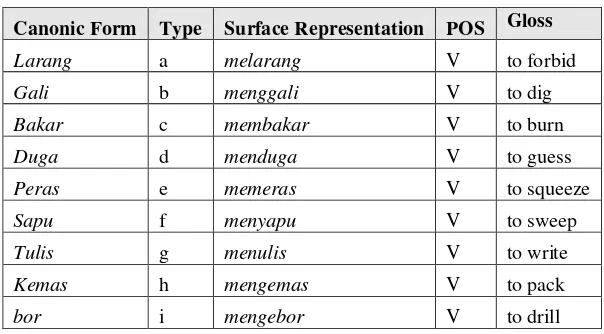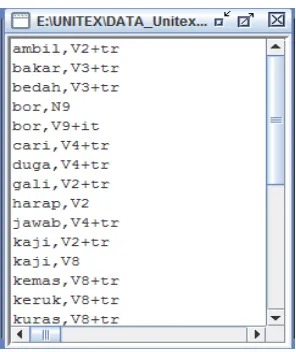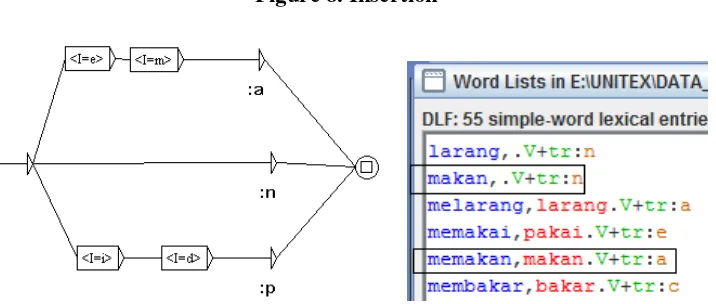LOCAL GRAMMAR BASED AUTO-PREFIXING MODEL FOR
morphology-phonology intersection or even semantics. This paper studies the same phenomenon from Natural Language Processing (NLP) application, and proposes an automatic prefixing model which can later be used to perform NLP tasks such as pattern matching and automatic extraction. The focus of this paper is the phenomena of meN- prefixing in Indonesian. The machine readable linguistic resources built in this paper is expected to transform the linguistic description pertaining to the morphophonemic constraints to an applicable mean for NLP. To accomplish this goal, Local Grammar (LG) approach is employed since this approach is very powerful to describe and formalize a linguistic phenomenon. A corpus processing software, UNITEX, is also employed to apply LG in carrying NLP tasks. It demonstrates how morphophonemic prefixing in Indonesian can be carried out automatically to generate an inflected form machine readable dictionaries as lexical resources and how the resources are used for pattern matching and automatic extraction. The existing linguistic resources from the experiment (machine readable dictionaries, regular expressions and LGGs) are maintainable, open for development and application in a larger corpus, and potential to be used to improve search engines performance for on-line documents in Indonesian.Keywords: Morphophonemic Constraints, Inflection, Natural Language Processing, Local Grammar
1. INTRODUCTION
(2) meN- sapu: some particular syntactic contexts. When they are prefixed with meN-, the outcomes are all verbs.
Some canonic forms in Indonesian do not allow direct concatenation with particular prefixes. Instead, it must go through several processes. Prefix meN- can be realized as meng- or men-depending on the initial sound of the canonic word that it inflects. Thus, it is called morphophonemic (Alwi, 1998:109-113). As it is described in example (1), the verb ambil prefers ‘ng’ (phonetically represented as /ŋ/). In the two examples, besides a word formation process (morphology), a nasal assimilation process (phonology) also takes place.
There are various perspectives to study the morphophonemic process in Indonesian. So far, studies concerning prefix meN- most commonly performed from the perspectives of phonology or morphology (Alwi 1988, Kager 1993, Ermanto 2008). However, very little concerns are given to how morphophonemic constraints apply in Natural Language Processing (NLP) by computer. Studying this phenomenon from NLP is also important since some computer applications rely heavily on language processing, such as: Question-Answer system, Text Mining, Information Extraction and etc.
The way a computer understands human language is different from what a human does. Linguistic resources (auditory, orthography, dictionary, grammar etc) for computer must be made machine readable for the input processing. Thus, it requires a tool that has both expressive power to describe the linguistic phenomena, and ability to carry out NLP tasks. To handle prefixing constraints on Indonesian morphophonemic, the tool must conceive a morphological analyzer.
There have been some efforts to build a morphological analyzer for Indonesian language, like studies performed by Hartono (2002) that employed PC-KIMMO. Pisceldo et al (2008) has also built another morphological analyzer and tested the analyzer to KBBI (Indonesian Standard Dictionary).
The morphological analyzer proposed in this paper will be applied to a text corpus (not dictionary) where language is actually in use. For this experiment, it requires a corpus and a processing software as a tool. The tool that fits the approach used by the writer in this paper is UNITEX, that has been tested in some languages like English, French, Korean, Chinese, Thai etciii. This software has a user friendly interface (even for non computational linguists/ computer scientists) and fits for linguists.
UNITEX is designed under the frame of Local Grammar (Gross 1993), that are very expressive in describing a local linguistic phenomenon. This corpus processing software can transform Local Grammar (LG) into LG Graph (LGG), a linguistic resource that is not only visual friendly but can also carry out NLP tasks such as pattern matching, automatic inflection, automatic extraction etc.
readable dictionary, and the application of the dictionary in a research corpus. Chapter 5 provides the conclusion of this paper that contains the summary and some perspectives for further research.
2. LOCAL GRAMMAR FORMALISM
2.1Local Grammar
Local grammar (LG) is a concept proposed by Maurice Gross (1993) to describe sequences that cannot be recognized by using previously existing rules; phrase structure rules and transformational grammar (e.g time and date expression). The basic idea is, LG can be constructed to capture recurring grammar and the resource can be use for description of larger linguistic construction; basically as bottom-up approach towards comprehensive description of language (Mason 2004:167). To apply this concept in NLP, a visual tool called Local Grammar Graph (LGG) is created (Zilberstein 1993). LGG has a very friendly interface even for a non-computer scientist.
2.2The Architecture of Local Grammar Graph (LGG)
The architecture of LGG resembles the notion of Formal Grammar (Chomsky 1956), and has the power equal to Context Sensitive Grammar or Algebraic Grammar (Paumier 2003), which will further be explored in section four. LGG supports the four components of Formal Grammar (N,Σ,P,S), where the first three are finite sets: Terminal, Non-Terminal, Production rule and Start Symbol. LGG is composed of start and end state, box (lexicon repository, either terminal or non-terminal) which is connected one and each other by lines. This section describes how LGG fits those components with some computational improvements so that it can be used to perform NLP tasks as it is shown in figure 1.
Figure 1. LGG Sample (Date Expression)
(3) In the morning, January the 1st (4) In the evening, February the 2nd (5) In the morning, March the 3rd (6) In the evening, April the 4th
(7) *In the morning, March the 5nd (not recognized)
2.2.1 Reference Graph
To write all the expressions manually in a graph is a laborious work. For example, when we want to extract all NPs (Noun Phrases) strings composed of a determiner ‘the’ plus any noun, it is quite impossible to write all the nouns in one graph. For this kind of problem, a reference graph can be one solution. This graph allows direct reference to an applied machine readable dictionary. Note that to use a reference graph, the corpus must have already annotated in preprocessing stage by a machine readable dictionary. Consider illustration 2:
Figure 2. Reference Graph Sample (NP)
The LGG sample in figure 2 shows a reference graph to nouns <N>. By using this reference graph, all NPs in the corpus consisting of [the + N], for instances: the man, the teacher, the computer etc, will be extracted easily.
2.2.2 Sub-Graph
Sub-graph is a method of referencing to another graph, instead of a referencing to a machine readable dictionary. The graph might be composed of terminal or non-terminal. In section 2.2.1, reference is made to the applied machine readable dictionary. But a sub graph can be applied directly with or without the application of a dictionary. In this way, a graph can be simplified and made systematic. Please refer to figure 3:
Figure 3. Sub Graph Sample
followings = pronoun + ‘will leave’ + a country name + date expression (sub graph). By using this sub-graph mechanism, it is also possible to create a production rule like [S NP + VP] in an LGG.
2.2.3 Recursiveness
It is possible to have a string where one part of the whole expression is repeated. For instance, we might have a sentence like, ‘you are very very kind’. In this sentence, the adverb ‘very’ is repeated twice. Even though not completely grammatical, in a conversation, the adverb ‘very’ is sometimes repeated to emphasize the modified constituent. To recognize this kind of expression, an LGG illustrated in figure 4 can be considered:
Figure 4. Recursiveness with a Loop
The loop attached on lexicon box ‘very’ is eomployed to recognize the repetition of the lexicon inside the box. It will recognize one, two, three, four or more repetition of ‘very’ in a sentence.
2.2.4 Transducer
Transducer is a mechanism where an LGG can be used to generate output. It is sometimes referred as LGG transducer or Finite State Transducer for it generates a finite set of output. For instance, in figure 2, the expression recognized by the graph is a determiner ‘the’ plus any noun, which constitute an NP. If required for the users, this information can be attached in the concordance display (result). Consider figure 4 and 5:
Figure 4. Transducer Sample
Figure 5. Concordance Sample
2.2.5 Inflection
Chomsky and Halle (1968) in SPE (Sound Pattern of English), describe rules that alter abstract phonological representations into surface forms through a series of intermediate representations and constraints. For instance the plural form of ‘apple’ is ‘apples’ but the plural form of ‘spy’ is not ‘spys’ or spyes’, but ‘spies. This morpho-phonological process which does not allow direct concatenation and involves contextual information, adopts context sensitive rewriting rules (Chomsky 1956, Partee et al 1993). It can be represented by the following mathematical notation:
Grammar Sample : A / α_
String : αA → α
When this rule ɲpplies, ɲ string ‘αA iv’ will change to ‘α ’ because of the α_ context. This happens to some particular English singular-plural form like spy-spies. The context sensitive grammar ranges from phonology to syntax. ‘Two-level morphology’ is one of the linguistic phenomena where this context sensitive rule applies (Koskienniemi 1983). Two level morphology later be improved by Karttunen (1983), Gajek et al (1983), Dalrymple et al (1983), and implemented as morphological analyzer PC KIMMO (Antworth 1990) downloadable in the repository of SIL (Summer Institute of Linguistics). Figure 6 shows a two-level morphology processing for English pluralization of spy to spies, where [+] shows a morpheme boundary:
Figure 6. Pluralization of ‘spy’ to ‘spies’
Pluralization of ‘spy’ shown in figure 6 can be described as two operations performed on a target string: [1] alternation of y -> i and [2] insertion of an epenthetic e.
In order to allow affixation on simple or multiword unit, the LGG must be designed to perform both direct concatenative and non-concatenative morphology. The mechanism to handle these phenomena in UNITEX is called ‘inflection graph’. Inflection graph allows these two operations to take place. Consider figure 7 from Paumier (2003):
The inflection graph, in figure 7, handles pluralization for words like ‘matrix’ to ‘matrices’, ‘radix’ to ‘radices’ etc. There are two paths for the output: Singular word (:s) and plural words (:p). Singular words will not be given any treatment (upper path), but for pluralization (:p) the words are treated with formula (Lces). This formula deletes one character from the rightmost, and added (ces). Therefore, ‘matrix’ will be ‘matrices’ and ‘radix’ will be ‘radices’. This inflection graph can be used to treat morphophonemic constraints in Indonesia. The constraints will be described further in section 3 of this paper.
2.3Pattern Matching with UNITEX
Pattern matching is a basic function of NLP which is also used in search engines like Google, Yahoo, Bing etc. UNITEX can comply with plain text written under Unicode font and HTML format. There are two options for pattern matching operation, which is by either regular expression or LGG.
The first operation is via regular expression. A pattern matching with regular expression is quite similar to the query in search engines, where target strings are typed into a query box. Besides dictionary reference, it is possible also to generate output by using regular expression. However, pattern matching is much more effective by using an LGG search, especially for multi word expressions. This leads us to the second operation, a pattern matching via an LGG. Figure 8 illustrates a pattern matching window where there is an option to apply regular expression or LGG:
Figure 6. Pattern Matching Window
There are two options in the window shown in figure 6. Users might perform a pattern matching via regular expression, or graph (LGG). A pattern matching via regular expression requires users to type the query. While a pattern matching via graph requires users to set a previously drawn LGG. LGG search is recommended for multiword extraction. We will look into the practice of this extraction in section 4, which focus on a corpus on Indonesian language.
3. MORPHOPHONEMIC RULES FOR PREFIX
(8) di-bakar
Example (10) illustrates the representation of the underlying form –N as /m/. The preference of nasal sound /m/ over other nasal sounds agrees to the initial sound of the word that it inflects (also known as assimilation). This phenomenon can also be referred as an example of context sensitive grammar ( N m/ meN_b). Nasal sounds in Indonesian are orthographically represented as the followings: /m/= m, /n/= n, /ŋ/= ng or / /= ny. When the word in canonic form is attached by prefix meN-, a newly generated POS is commonly verb. A lexicon goes through the following schema (Pisceldo, 2004:5) before it gets prefixed by meN-. Consider figure 7:
Figure 7. Lexicon Path
The above lexicon path illustrates how lexicons are prefixed. Morphotactic rules of Indonesian notes that prefixing of me-vi to the stem results on a transitive verb. But before it is represented on the surface, the stem words must undergo the following morphophonemic constraints (adapted from Alwi 1998 in Pisceldo 2004)vii as it is represented in table 1:
Table 1. Morphophonemic Constraints for Indonesian Prefix
meN-Morphophonemic Process of meN Orthographical Representation of the
initial phoneme of the wordviii
e delete first letter of stem ‘mem' insertion concatenation p
f delete first letter of stem ‘meny’ insertion concatenation s
g delete first letter of stem ‘n' insertion concatenation t
h delete first letter of stem ‘meng' insertion concatenation k
i menge- insertion concatenation - one syllable word
There are nine types of prefixing listed on table 1, but they can actually be narrowed down into three
Canonic Form Type Surface Representation POS Gloss
Larang a melarang V to forbid
The constraints are not always clear cut. There are some irregularities, which involves other linguistic aspects too, like semantic. As an example, the canonic forms kaji might have two different inflected forms. The first one mengaji follows the prefixing rule by deleting the first letter k. Another one, mengkaji maintains the k. Alwi et al (1988) believes that these two forms are used for meaning distinction. Mengaji is often associated with the activity of reading quran (the holy book for muslims), while mengkaji is associated to the activity of examining something thoroughly.
Some words might undergo POS shift when they are prefixed. As an example, bor is a noun, but when this word is prefixed with meN-, the POS shifts to a verb. But in some cases, we might also find the use of bare bor as a verb. In this case, the word does not undergo POS shift. Consider the examples (11) to (13):
(11) Bor itu sudah rusak (N)
(12) Kami akan mengebor tanah (V) (13) Bor tanah itu! (V)
4. LOCAL GRAMMAR GRAPHS AND AUTOMATIC EXTRACTION FROM RESEARCH CORPUS
This section describes the procedures undergone for the experiment in this research, and proposes a model for machine readable dictionary building and automatic extraction NLP task for Indonesian language.
Some canonic forms (also known as dictionary form) with different types of meN- prefixes were collected randomly. The list was used to build an uninflected word machine readable dictionary. This uninflected word dictionary was then inflected with specifically designed inflection LGGs to comply with constraints pertaining to the morphophonemic phenomena of each meN- prefixing types. The inflection, in turns, automatically created an inflected word machine readable dictionary. Then, the existing inflected word dictionary was applied to the text corpus in preprocessing stage for the corpus annotation. After the corpus was annotated, pattern matching and extraction tasks were carried out by either a regular expression, or a graph. These process and the essential components that support it are described in the following sub sections.
4.1Canonic Form Dictionary
There are 28 canonic forms selected to represent the nine types of morphophonemic constraints described in section 3 of this paper. The words are collected and written in UNITEX uninflected dictionary format (entry line formalism). The format comprises at least a POS and an inflection code. Consider figure 8:
Figure 8. Canonic Form Dictionary
correct inflection LGG in inflectional LGGs repository and automatically create inflected words dictionary. The procedures are described in section 4.2.
4.2 Inflectional LGGs and Inflected Words Dictionary 4.2.1 LGGs for Insertion and Substitution
There might be a terminology problem considering the term, ‘inflectional’ LGGs as in morphology the term ‘inflection’ and ‘derivation’ is distinguished. However, in UNITEX, all affixes are handled by inflectional LGGs, regardless of the resulting word forms as an inflection or derivation.
As commented in the section three, there are two categories of prefixing. One is insertion; another one is substitution, which involves deletion. In inflectional LGGs, UNITEX use the following codes for the two constraints:
<I=?ix> inserts the letter ? before the initial letter of the original word. <X=nx> removes the first n letters of the original word.
The codes must be written in the LGG boxes. Consider figure 8 which consists of an LGG on the right, and the resulting inflected form dictionary on the right:
Figure 8. Insertion
There are three lines for the LGG presented in figure 8. The upper line is used to insert me to target word, like larang to melarang (to forbid), makan to memakan (to eat), mulai to memulai (to start). Note that the underlying form N- is not represented in the surface form so that the prefix me- (as insert) can be concatenated directly to target stem. This kind of prefixing is assigned with a code. This code will appear in the inflected word dictionary, by the end of the entry line (Figure 8 right). Since there are nine types of constraints, then eight different inflection LGGs are created (a to i).
The middle line is used to indicate zero inflection. In a sentence like makan buah itu!, without prefix, the word makan is identified as a verb. This will give two possibilities in the processing to identify makan and memakan from the same basic form. This zero prefix is assigned with n code (figure 8 right).
Figure 9. Zero Prefix, Insertion and Deletion
Unlike the LGG represented in figure 7, the LGG represented in figure 8 comprises of different prefixing operations. The upper line handles a prefixing constraint that includes deletion and insertion. As an example, this LGG inflects tanam to menanam by removing the first t in tanam, and insert men. This operation applies for stems that require deletion, which are type e, f, g, h. Consider figure 10, which is a text automaton from the sentence containing menanam:
Figure 10. Text Automaton for menanam
If UNITEX recognizes a particular surface form that comes from basic form (inflected from, uppercased string), it will display both surface and basic form. Surface form is the form that is available on text, and basic form is a form that is available in the dictionary. As an example, figure 10 shows menanam, an inflected (surface) form of tanam. Below the automaton box, it also displays the codes (POS and inflection codes). Therefore, from the codes we might know that menanam is a verb, and it has a basic form tanam, and when prefixed with meN- it undergoes t deletion, and m insertion (prefixing constraint type g).
4.2.2 One Syllable Word Prefixing
Figure 11. One syllable Prefixing LGG
Figure 12. Text Automaton for mengebor
4.2.3 Different Prefixing Methods for one Canonic Form
One uninflected form can sometimes be prefixed with more than one LGGs since the stems might potentially take different prefixes. For example, when meN- is used to inflect kaji. There might be two correct forms: mengaji (deletion applies) and mengkaji (deletion does not apply). The first prefixed form (k deleted form) refers specifically to the activity of reading quran (the holy book for Muslims), while the second prefixed form refers to the activity of examining something thoroughly. Therefore, in the machine readable dictionary applied for the corpus processing in this research, these two forms are generated via the automatic prefixing of two different LGGs. Consider LGGs represented in figure 13, and the inflected form dictionary for mengaji and mengkaji in figure 14:
Figure 14. mengaji and mengkaji in the Inflected word Dictionary
4.2.4 Different POS for one Canonic Form
One word with different POS should be tagged with different tags. In UNITEX machine readable dictionary, this kind of word must be written by multiple entries comply to the POS tags. For example, mulai has two different POS tag, one as a verb as in pertemuan itu dimulai dengan pemukulan gong or as a preposition mulai sekarang, kita adalah teman. The text automaton resulted from the preprocessing can display all possible tags (ambiguity), as it is represented in figure 15 for bor:
Figure 15. Ambiguity
4.3Research Corpus, Pattern Matching and Automatic Extraction
Previous sections have discussed types of LGGs used in this research. These LGGs are used to inflect a canonic form dictionary to generate an inflected form dictionary. When this inflected form dictionary is ready, it must be applied to a corpus via preprocessing for the corpus annotation. Figure 16 shows the text automaton where the corpus is already preprocessed. The corpus is collected from various websites; but the contents can generally be divided into two. One is from newspaper websitesxii, another is from blogsxiii. Note that the stylistic of newspaper websites is commonly formal, while the stylistic of blogs may vary.
The corpus is preprocessed with both simple and inflected form dictionaries. The inflected forms dictionary is automatically generated by the LGGs described in the preceding sections. Consider the preprocessing result represented in figure 16:
Figure 16. Preprocessed Text
Figure 16 is divided into two parts. The left part displays a corpus that has been preprocessed with simple and inflected form dictionaries. It also shows the statistics generated from UNITEX computation. It detects 518 sentence delimiters, 22739 tokens and 3296 types.
The right part displays a word list from tokens recognized by the dictionaries. It also display a list of unknown words; words that are not in the dictionary. If the dictionary is accurate enough, the list of unknown words usually contains proper names.
This paper focus on extraction of target strings. Target strings may cover a single word, or multiword expressions (phrase). There are three type of extractions described in this paper; word form-based extraction and code based extraction (performed with regular expressions) to extract words, and complex extraction (performed with graphs) to extract multi word expressions.
4.3.1 Word Form Based Extraction (Regular Expressions)
retrieve ambil and its variations like ambil, diambil, mengambil, most likely they have to perform three queries (for each word forms, excluding the canonic form).
With word forms search, the users need only one time query for the whole searching. This operation retrieves the preprocessed corpus, matching the target query and its inflected forms. In UNITEX, the regular expression for this operation is angel bracketing on the query: <query>. When performing search with graph, the syntax must be expressed in the same way as in the regular expression. By employing this operation, bor, dibor, and mengebor can be retrieved and extracted by only one query: <bor>. Consider the concordance for query <bor> in figure 17:
Figure 17.Concordance for Query <bor>
4.3.2 Code-based Extraction (Regular Expression)
The search can also be performed by using codes written in the dictionary (reference). The more complicated code has consequence on tightening the constraints. For example, query <TOKEN> retrieves and extracts all word forms. With this query, all words, regardless of the POS, simple or inflected, are retrieved and extracted. If the constraint is tightened to just verbs, then the query should be <V>. This query is meant for retrieving and extracting all verbs regardless of the word forms (It cane inflected or uninflected forms) as illustrated by figure 18:
Figure 18 is the concordance for query <V> which calls all verbs regardless of the word forms. It shows bor-mengebor-dibor from the basic form bor, tanam-menanam from the basic form tanam, mengaji-mengkaji from basic form kaji. This constraint can still be tightened. Query <V:a> retrieves and extracts only verbs that are prefixed with rule a, where the underlying form of N (of meN-) is realized as zero. Consider figure 19:
Figure 19. Concordance for Query <V:a>
Each prefixing type in the machine readable dictionary in this research takes different codes. Hence, users might focus their search only one prefixing types, or a collection of few. So far, pattern matching operation is performed via regular expression. However, regular expression is effective when the query is not beyond word level. When more complex query is requested (multi word), a graph will be more effective for a retrieve and extraction task.
4.3.3 Complex Extraction (Graph)
A query might not just be limited to word forms, but a query also allows for more complex extraction (longer strings) like compounds or phrases. For a complex extraction, the pattern matching operation is much more comfortable to be carried out with an LGG instead of a regular expression. Consider a transducer graph in figure 20, and the result in figure 21.
Figure 20. A Transducer Graph for Pattern Matching and Extraction of Passive Agent
Figure 21. Extraction Result for Passive Agent
transducer type. With the following regular expression query (<V:p>oleh<TOKEN>), UNITEX will extract only target strings without giving any output as in figure 21. Please consider figure 22:
Figure 22. Extraction with Regular Expression
More advanced user might want to use left context operation. This operation order the left part of the strings to be the target retrieval context as it is illustrated in figure 24, with LGGs in figure 23:
Figure 23. Using (Left) Context
Figure 24. Result Extraction with (Left) Context
The LGG represented in figure 23 indicates that the target query is only the agent. To make the pattern matching accurate, context is included. The target query must be preceded by two tokens: the first one is verb in passive form, and another one is preposition oleh. From the LGG, the result in figure 24 is obtained. See the difference with figure 21 and 22, where context is not established. In the previous result, the passive verbs and the preposition are included in the result, where in the search with context, they are not included in the research.
5. Conclusion
By focusing on some particular type of stems, I have described my proposal for the automatic retrieval and extraction of meN- prefixed word forms. Morphophonemic constraints of prefix meN-have been formalized with LGGs so that it can further be used to carrying various NLP tasks. I meN-have demonstrated how the linguistic resources proposed in this research can be used to perform pattern matching and extraction tasks.
Indonesian language. These resources are maintainable and open for further development. But the most important future work is building a complete uninflected word dictionary for Indonesian. Only by having this resource the subsequent resources can effectively be created and employed, and in turn can perform a sufficient corpus annotation.
Another important work to do is to standardize (and widely publish) the morphophonemic constraints such as for reduplications, allowed affixes (meN-guna-kan and meN-guna-*i), double prefixes (menggunakan-mempergunakan-mem*ergunakan) xiv, consonant cluster (meN-transfer realized as mentransfer instead of men*ransfer), and other irregular morphophonemic constraints. If they are already standardized, then LGGs can be used to formalize the constraints, and in turn, an inflected form dictionary can be created and used to perform various NLP tasks in Indonesian corpus.
References
Amas, S. (2009). Bentuk Memperhatikan dan Memperkosa. Jurnal sosioteknologi : membaca arah pembangunan
Indonesia melalui sejarah bangsa : 8 (18): 745 - 747
Alwi, H- D, et al. (1998). TataBahasa Baku Bahasa Indonesia. Balai Pustaka: Jakarta
Chomsky, N (1956). Three models for the description of language. IRE Transactions on Information Theory (2):
113–124. http://www.chomsky.info/articles/195609--.pdf.
Departemen Pendidikan Nasional, (2008). Kamus Besar Bahasa Indonesia. Edisi Keempat. Jakarta : PT Gramedia
Pustaka Utama.
Chomsky, N, and M. Halle. 1968. The Sound Pattern of English. New York: Harper and Row. xiv, 470 pages.
Reprinted 1991, Boston: MIT Press.
Ermanto.(2008). Fungsi dan Makna Afiks Infleksi pada Verba Afiksasi Bahasa Indonesia: Tinjauan dari Perspektif
Morfologi Derivasi dan Infleksi.Bahasa dan Seni, Jilid 36, No 1:Fakultas Sastra Universitas Negeri Malang.
Gross, M. (1993). Local Grammars and their Representation by Finite Automata. In Data, Description, Discourse.
Papers on the English Language in honour of John McH Sinclair, M. Hoey (Ed.) (1993) 26-38.
Lewis, M.P. (ed.). 2009. Ethnologue : Languages of the World. 16th edition. Dallas : SIL International. Online
version at http://www.ethnologue.com/.
_______. (1968). Grammaire transformationnelle du francais., vol. 1, Syntaxe du verbe. Larousse.
Martin-Vide.C. (2004). Formal Grammar and Language, in TheOxford Handbook of Computational Linguistics.
Mitkov, R (Ed) (2004): 157-177.
Max, S. (1993). Dictionnaires électroniques et analyse automatique de textes : le système INTEX. Masson Ed.: Paris
Press: Oxford.
Paumier, S. (1998). Unitex Manual 2.1. Université Paris-Est Marne-la-Vallée: Paris
Pischeldo, F., et al. A Two-Level Morphological Analyser for the Indonesian Language. In Proceedings of the 2008
Australasian Language Technology Association Workshop (ALTA 2008), pages 142– 150. Hobart, Australia
Throst, Harold. (2004). Morphology, in The Oxford Handbook of Computational Linguistics. Mitkov, R (Ed)
Endnotes
i
Abbreviations used in this paper: LG (Local Grammar), LGG (Local Grammar Graph), NLP (Natural Language Processing), POS (Part of Speech), NP (Noun Phrase), PP (Prepositional Phrase)
ii
N refers to nasal sounds, which might be represented as /m/, /n/, / / or /ŋ/
iii
http://igm.univ-mlv.fr/~unitex/ (no module is available yet for Indonesian Language)
iv
Nonsense string
v
Glosses taken from IMT (interlinear Morpheme Translation): PASS (Passive), ACT (Active)
vi
For computer processing, abstract underlying form of nasal (-N) is removed. Thuse, basic prefix is considered to
be me-. This will not affect the prefixing results. The generated prefixed words will still be in correct forms.
vii
Alwi et al (1988) noted that as Indonesian language keeps improving complying to the language use in social life, changes concerning the rules may apply.
n signifies the order of the letter to be removed
xi
To solve this problem, one must apply disambiguation grammar.
xii
News/Newspaper websites: Kompas (www.kompas.com) , Seputar Indonesia (www.seputar-indonesia.com) ,
Tempo (www.tampo.co) , Antara (www.antaranews.com)
xiii
Blogs: www.blogspot.com, www.wordpress.com, www.kompasiana.com
xiv
In KBBI (Indonesian Standard Dictionary), there are two circumfixed (me-kan) form of perkara, which is
memperkarakan (as a sub entry of perkara), memerkarakan (as a synonym of mengacarakan, sub entry of acara). If
it is assumed that p is deleted only when it is the initial phoneme of a canonic word, then memerkarakan should be
the correct form instead of memperkarakan. This conforms to mempergunakan, since the canonic form is guna, and
